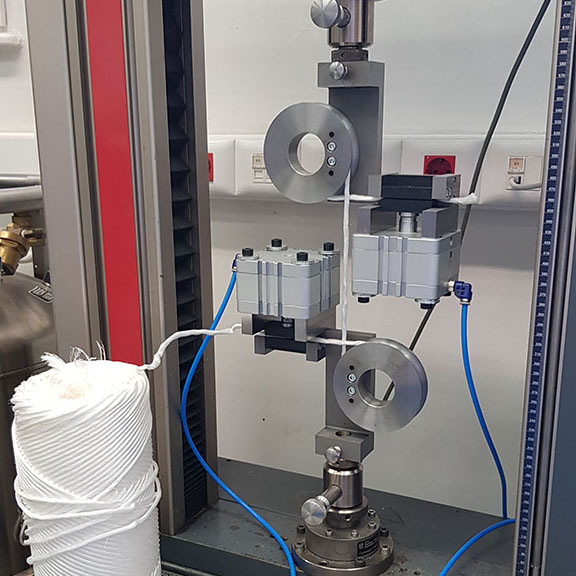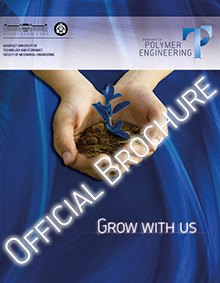Developing of increased load-ability polypropylene and environmental friendly material based bale twines
Dr. Tamás Bárány
Dr. Kolos Molnár
Dr. Péter Bakonyi
Prof. Dr. László Mihály Vas
Dr. Ákos Kmetty
Dr. Ábris Dávid Virág
Gergely Csézi
László József Varga
Project summary
When cereals are harvested, the straw is compacted by dedicated machines into cylindrical or rectangular bales and then stored this way. In order to keep the finished bale in shape, various binders are used, the most common one is the highly oriented polypropylene (PP) twine or netting that is manufactured by advanced technologies. It is common for relatively rigid twines to break during machine knotting, hence the time to round bales increases significantly. On the other hand, weather conditions (rainfall, sunlight, temperature) during the storage of the finished bales can cause the twines to break, making subsequent utilization difficult. By improving the properties of baler twines, baling itself and picking up the bales become more stable and simple, less time consuming and safer, and thus increase the efficiency of bale forming and handling. Nowadays, many manufacturers are continuously developing their baling machines to best meet the needs of a wide range of customers. The customer community needs more than just a robust machine these days. They have a demand for a multitude of high-quality technical solutions that can make their day-to-day work significantly easier and faster. They need to ensure control from a comfortable cab, and the high-performance baler should create a sufficiently compact, securely fixed bale. This project wants to work out a solution to this important market demand, a problem which current machine manufacturers and farmers are experiencing. Due to the increased transportation costs, there is a demand to be able to transport the most forage and straw in a given volume, which is why machine manufacturers are producing balers working at higher and higher pressures. The approach used so far has been to use thicker twines, which have now reached their limits as under 100 m/kg the product is too thick and unmanageable from both the production and the application side. A reasonable and the only feasible solution is to produce twines with higher tensile and knot strength in the lightest (m/kg) form possible. This approach also meets the current societal expectation of appropriate plastic waste management, as the mass of plastic used decreases as the bale size increases. As part of the planned research project, TAMA, in consortium with BME-PT, would advance a twine for baling for which we identified two major directions of research. The first one is the development of the existing PP bale cords and the related manufacturing technology in order to achieve greater tensile strength, greater elasticity (greater elongation), lower weight and lower heat relaxation tendency and, as a result, the development of a more compliant twines. In this case, it is expected that the baling twines and the knot created will break at a higher force, thus increasing the efficiency of the baling process and reducing the time required. The other main direction is to develop the production technology for the twines originally made of PP in order to change it for an environmentally friendly, renewable resource-based polymer that is also biodegradable (so-called biopolymer). In this case, even greater environmental awareness can be achieved by replacing PP bale twines with biopolymer-based ones, which eliminates the direct deposition of conventional, petroleum-based, non-biodegradable plastics onto fertile lands. For both directions of the current development, our goal is to create a ready-to-use, practical bale twine. The competitors' developments is pointing towards one-way, thicker products, suggesting that they want to solve the problem with even greater amounts of plastics. Therefore, we believe that the successful development would provide a significant competitive advantage for the company.
Project results

Project-related publications
- Vas L. M., Slezák E., Molnár K., Ronkay F. Gy.: Advanced avrami formula and its application to describing the isothermal crystallisation of polymers. Thermochimica Acta, 746, 179950/1-179950/19 (2025) 10.1016/j.tca.2025.179950 IF=3.1 Q2
- Tábi T., Gere D., Csézi G., Pölöskei K.: Influence of Epoxidized Natural Rubber of the thermoformability of Poly(Lactic Acid) biopolymer films using elevated temperature ball burst tests. Journal of Thermal Analysis and Calorimetry, 149, 75-87 (2024) 10.1007/s10973-023-12712-1 IF=3 Q2
- Dragan V. K., Petrovics N., Kirchkeszner Cs., Tábi T., Szabó B. S., Eke Zs.: The kinetics of swelling and migration: A case study of plasticized polylactic acid food contact plastics tested with ethanolic food simulants. Express Polymer Letters, 18, 391-405 (2024) 10.3144/expresspolymlett.2024.29 IF=2.7 Q2
- Varga L. J., Görbe Á., Bárány T.: Amorf poli-alfa-olefinnel adalékolt polipropilén mátrixú nyújtott nanokompozitok fejlesztése. Polimerek, 9, 27-32 (2023)
- Tábi T.: Háromfázisú bioműanyag keverékek vizsgálata. in 'XXXI. Nemzetközi Gépészeti Konferencia (OGÉT 2023) Temesvár, Románia. 2023.04.27-2023.04.30.,460-465 (2023)
- Csézi G., Tábi T.: Hőkezelési hőmérséklet hatása a nyújtott politejsav tulajdonságaira. in 'XXXI. Nemzetközi Gépészeti Konferencia (OGÉT 2023) Temesvár, Románia. 2023.04.27-2023.04.30.,75-80 (2023)
- Mészáros L., Horváth A., Vas L. M., Petrény R.: Investigation of the correlations between the microstructure and the tensile properties multi-scale composites with a polylactic acid matrix, reinforced with carbon nanotubes and carbon fibers, with the use of the fiber bundle cell theory. Composites Science and Technology, 242, 110154/1-110154/9 (2023) 10.1016/j.compscitech.2023.110154 IF=8.3 Q1
- Petrovics N., Kirchkeszner Cs., Patkó A., Tábi T., Magyar N., Kovácsné Székely I., Szabó B. S., Nyiri Z., Eke Zs.: Effect of crystallinity on the migration of plastic additives from polylactic acid-based food contact plastics. Food Packaging and Shelf Life, 36, 101054/1-101054/11 (2023) 10.1016/j.fpsl.2023.101054 IF=8.5 D1
- Varga L. J., Görbe Á., Bárány T.: Polypropylene blends for highly drawn tapes with improved toughness. ACS Omega, 8, 22827-22835 (2023) 10.1021/acsomega.3c01772
- Ageyeva T., Kovács J. G., Tábi T.: Comparison of the efficiency of the most effective heterogeneous nucleating agents for Poly(lactic acid). Journal of Thermal Analysis and Calorimetry, 147, 8199-8211 (2022) 10.1007/s10973-021-11145-y IF=4.4 Q1
- Petrovics N., Kirchkeszner Cs., Tábi T., Magyar N., Kovácsné Székely I., Szabó B. S., Nyiri Z., Eke Zs.: Effect of temperature and plasticizer content of polypropylene and polylactic acid on migration kinetics into isooctane and 95 v/v% ethanol as alternative fatty food simulants. Food Packaging and Shelf Life, 33, 100916/1-100916/10 (2022) 10.1016/j.fpsl.2022.100916 IF=8 D1
- Tábi T., Pölöskei K.: The effect of processing parameters and Calcium-stearate on the ejection process of injection molded Poly(Lactic Acid) products. Periodica Polytechnica-Mechanical Engineering, 66, 17-25 (2022) 10.3311/PPme.18246 IF=1.3
- Varga L. J., Bárány T.: Development of drawn polypropylene-based blends and composites. IOP Conference Series: Materials Science and Engineering, 1246, 012023/1-012023/8 (2022) 10.1088/1757-899X/1246/1/012023
- Tábi T.: Talkum hatása a politejsav biopolimer tulajdonságaira. in 'XXX. Nemzetközi Gépészeti Konferencia (OGÉT 2022) Székelyudvarhely, Románia. 2022.04.21-2022.04.24.,5 (2022)
- Tábi T., Ageyeva T., Kovács J. G.: The influence of nucleating agents, plasticizers, and molding conditions on the properties of injection molded PLA products. Materials Today Communications, 32, 103936/1-103936/8 (2022) 10.1016/j.mtcomm.2022.103936 IF=3.8 Q2
- Tábi T.: Tények és tévhitek a biopolimerekkel kapcsolatban - I. rész (másodközlés). Polimerek, 7, 298-301 (2021)
- Tábi T.: Tények és tévhitek a biopolimerekkel kapcsolatban - II. rész (másodközlés). Polimerek, 7, 337-340 (2021)
- Tábi T.: Fröccsöntött politejsav biopolimer sorozatgyárthatóságának elemzése. in 'XXIX. Nemzetközi Gépészeti Konferencia (OGÉT 2021) Románia. 2021.04.23.,200-203 (2021)
- Csézi G., Tábi T.: Orientált biopolimer szerkezetek vizsgálata. in 'XXIX. Nemzetközi Gépészeti Konferencia (OGÉT 2021) Románia. 2021.04.23.,101-105 (2021)
- Tábi T., Ageyeva T., Kovács J. G.: Improving the ductility and heat deflection temperature of injection molded Poly(lactic acid) products: A comprehensive review. Polymer Testing, 101, 107282/1-107282/36 (2021) 10.1016/j.polymertesting.2021.107282 IF=4.931 D1






